New Playing Cards for the French Republic (1793-94)
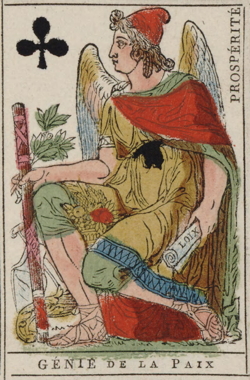 |
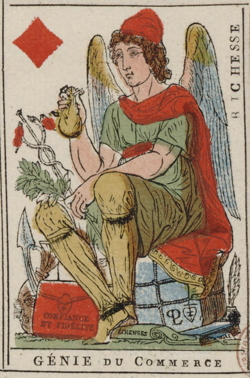 |
This is a playing card from a charming collection of new designs for a deck which were issued during the French Revolution (1793-94). They were designed by moderate liberal republican supporters of the revolution (which included people such as the Marquis de Condorcet) who believed in the rule of law, free markets, the equality of women under the law, and the emancipation of slaves. As they said in their pamphlet they wanted to reinforce the principles of the revolution in such everyday items as playing cards, since the traditional designs had face or "court" cards depicting Kings, Queens, and Jacks who were the beneficiaries of the old privileged political order which had just been overthrown. It seemed obvious to them that a new design even for such mundaine things as playing cards was required under the Republic to reflect the new principles of government and which "the love of liberty demands". Here we show "The Spirit of Peace" (equivalent to the Queen of Clubs) which the designers explain as follows: ""Peace" is seated on an ancient seat and is holding in one hand the roll of the laws, in his other hand is the fasces signifying concord and on which is written the word "Union". Lying near him are a cornucopia and a plowshare; an olive branch which he is holding in his right hand shows its influence and justifies the word "Prosperity" which is placed next to him." An intriguing aspect of the designs was the important role which they gave to economic liberty: the Spirit of Peace" has as his motto "prosperity"; the "Spirit of Commerce" has for his "wealth"; and the "Liberty of the Professions" has "industry". Thus fully one quarter of the face cards deals with one or another aspect of economic freedom.
This guide will provide high resolution images of the new designs, a translation of some of the explanatory descriptions which accompanied them, and some commentary on the meaning and significance of these images.
Source and Copyright
Nouvelles cartes de la Republique française. Plus de rois de dames de valets; le génie, la liberté, l'égalité les remplacent: la loi seule est au dessus d'eux (Paris: U. Jaume et J.D. Dugourc, 1793-1794).
- Copyright: The text is in the public domain.
- URL <https://catalogue.bnf.fr/ark:/12148/cb40254159r>
- Source : Bibliothèque nationale de France, département Estampes et photographie.
The Title Page showing the complete set of Face Cards
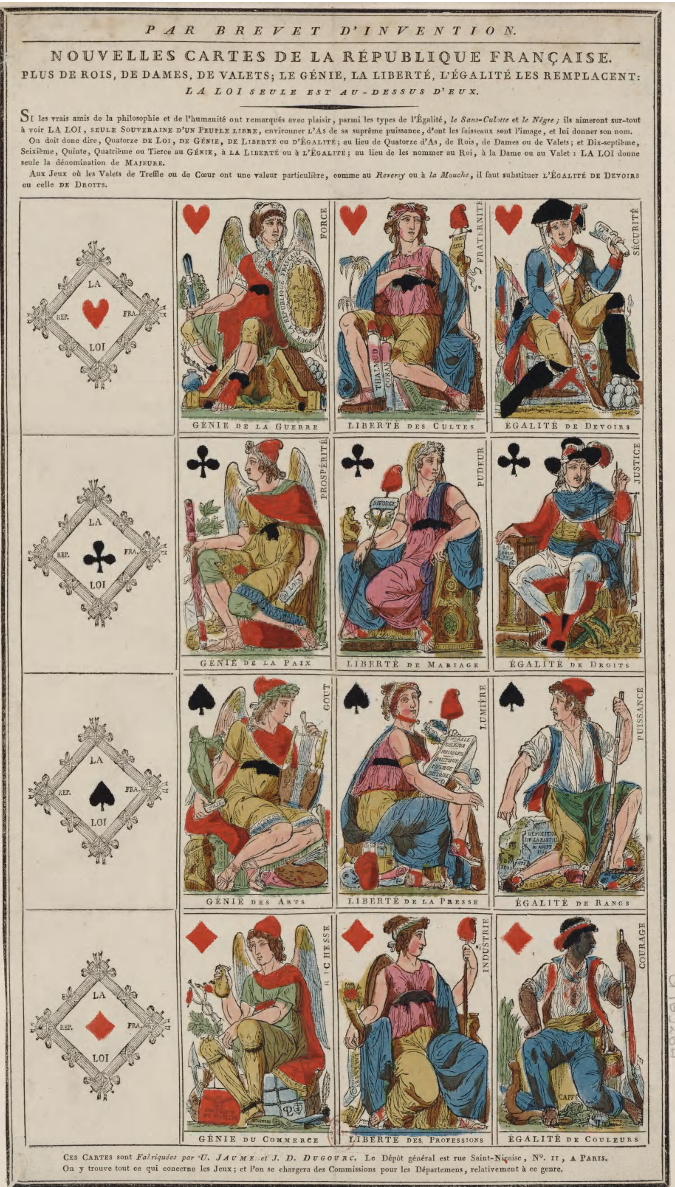 |
Introduction
This pamphlet was an announcement or even an advertisement of a new design for playing cards that were more suitable for the conditions of post-revolutionary France than the traditional "feudal" or aristocratic designs. They were created by Citizens Jaume and Dugourc of Paris in 1793-94 and enjoyed a grant of patent or copyright ("brevet d'invention") which probably lead them to believe the venture would be a profitable one. One motivating factor was the blatent contradiction they could see between playing cards which showed representatives of the old order (kings and queens and knights) which had so recently been overthrown in a bloody revolution. To right thinking republicans and to others "of taste" the constant reminder of the leaders of the old order, caused even by looking at the face cards of a deck of cards was offensive:
It is not (just) Republicans who might make use (even in jest) of expressions which constantly recall despotism and inequality, there was no person of Taste who was not shocked by the contradiction of the figures on playing cards and the insignificance of their names.
So Citizens Jaume and Dugourc set about creating new playing cards which could serve not just as a means to while away the hours in pleasant games but which would also be a "Manual of the Revolution", reminding players of "the spirit of all the characters of Liberty and Equality". In typical Cartesian manner they created a strictly rational and hierarchical structure to depict these "characters of Liberty and Equality". They came up with a double hierarchy. Firstly, vertically across the different suits there are the republican and revolutionary equivalents of the aristocratic ace, king, queen, and knight - namely, the law, the spirits, liberties, and equalities. These are explained in more detail below and are quite well articulated by the designers in their pamphlet. Secondly, there is an order horizontally within each suit the meaning of which is harder to determine. This will not be explored here until a later date.
Overview
The image is in the shape of a square made up of 4 cards across (the suits of hearts, clubs, spades, and diamonds) and 4 cards down (the court cards or denominations). The designers have retained the traditional suits but have changed the names of the face cards or court cards (ace, king, queen, knave). The Ace cards have become "The Law" cards, the Kings have become "Spirit" cards, the Queens have become "Liberty" cards, and the Knaves (or Knights) have become "Equality" cards.
When one reads across the image (following the suits) we can see the following relationships:
- the suit of Hearts includes "the Spirit of War", the "Liberty of Religion", and the "Equality of Duties" (presided over by the "Ace of the Law (of the French Republic)" [See larger size image 1200px]
- the suit of Clubs includes "the Spirit of Peace", the "Liberty of Marriage", and the "Equality of Rights" (presided over by the "Ace of the Law (of the French Republic)" [See larger size image 1200px]
- the suit of Spades includes "the Spirit of the Arts", the "Liberty of the Press", and the "Equality of Rank (Classes)" (presided over by the "Ace of the Law (of the French Republic)" [See larger size image 1200px]
- the suit of Diamonds includes "the Spirit of Commerce", the "Liberty of the Professions", and the "Equality of Coloured People (Races)" (presided over by the "Ace of the Law (of the French Republic)" [See larger size image 1200px]
Reading down the image we encounter cards of the same rank or denomination, which were once taken by the Aces, Kings, Queens, and Knights (Knaves). These are the groupings which we will discuss below in more detail.
The New "Court Cards) ("Dénominations")
The Law (la Loi) replaces Aces (les As)
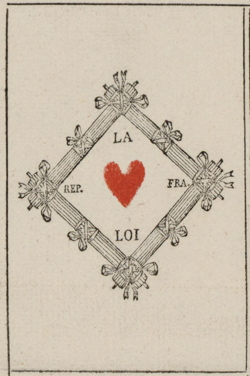 |
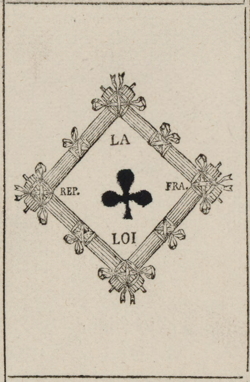 |
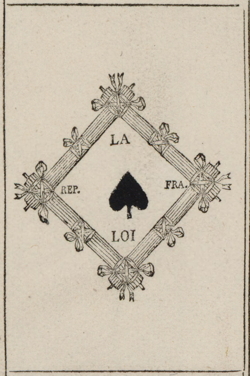 |
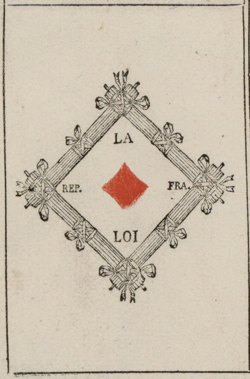 |
The common elements for all the Ace cards is the statement "The Law (of) the French Republic", and a square made up of four Roman republican fasces lashed together (affirming the idea that individual rods are unbreakably strong when they are united together). The commentary in the pamphlet states:
If the true friends of philosophy and humanity have noticed with pleasure that included among the Equality face cards are sans-culottes and negroes, they will especially like to see The Law as the sole sovereign of a free people. It surrounds the Ace of the supreme power, whose symbol is the fasces, and provides it with its name. [p. 3]
By making "the Law" the dominant face card of each suit the designers are making the point that the rule of the law is the supreme or governing force of the new French society. Everything which falls beneath it is under its jursidiction or "sovereignty". It derives its authority from both moral philosophy and the strength of the people (represented by the roman fasces).
Spirit (la Génie) replaces Kings (Rois)
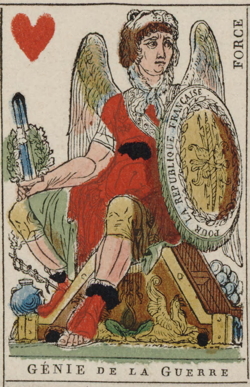 |
 |
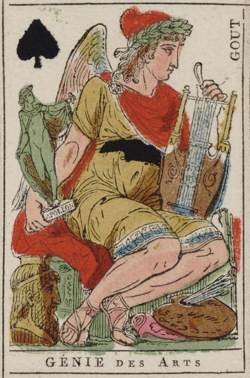 |
 |
Beneath the law comes the next highest face card in the suit. Literally under the jurisdiction of the Law comes the four driving forces or "Spirits" (la Génie) - War, Peace, the Arts, and Commerce - which together determine the direction society takes.
All four "Spirits" (or Geniuses) are depicted as winged gods with a strong Roman appearance (and are all male). "War" wears a lion skin over his head and shoulders but the other three wear the red Phrygian cap (or "liberty cap") which is the symbol of the freed slave. The following descriptions come from Jaume and Dugourc's pamphlet [comments by the editor are in square brackets].
"War" is holding in one hand a short sword surrounded by a laurel wreath ("a civic crown"), in his other hand he is holding a shield which is decorated with lightning bolts and a laurel wreath and on which one can read "For the French Republic". He is seated on a mortar which is the symbol of military steadfastness. To the side is written the word "Force" which is represented by the lion's skin which is draped around his head. [p. 1] [Editor: there appears to be a mythical beast, a griffin, at the feet of War. Griffins had the body of a lion and the head and wings of an eagle and were thus symbols of great courage and ferocity].
"Peace" is seated on an ancient seat and is holding in one hand the roll of the laws, in his other hand is the fasces signifying concord and on which is written the word "Union". Lying near him are a cornucopia and a plowshare; an olive branch which he is holding in his right hand shows its influence and justifies the word "Prosperity" which is placed next to him. [p. 2]
"The Arts" is holding in one hand a lyre and a plectrum, in his other hand he holds a statue of Apollo. He is sitting on a block of stone on which are carved hieyroglyphics and is surrounded by instruments or products of the Arts. A laurel crown and a Liberty cap adorn his head, to the side is the word "Taste". [p.2] [Editor: At the feet of "The Arts" is a painter's palette and the head of a statue].
"Commerce" holds in his hands a purse, the caduceus, and an olive branch which are symbols of Mercury. His boots shows his indefatigable activity and his face reveals his deep thoughts. He is sitting on a bail of goods and his wallet, papers, and book are at his feet, showing that confidence and reliability are the foundation stones of commerce, just as exchanges are its means, and order ensures its safety. [p. 2] [Editor: At the feet of "Commerce" are an ink well and quill pen, a satchel or brief case with the words "Confidance and Fidelity" written on it, a wallet with the word "Exchange" written on it, and a book with a slip of paper inserted in it with the word "Order" written on it. The bail of goods has 2 symbols on it - a combined P and L and a heart with a cross through it, the meaning of which is not clear].
What is interesting about the four driving forces of society depicted here is that two of them involve economic activities - "Peace" has a plowshare at his feet and his motto is "prosperity"; "Commerce" is sitting on some cargo and has a ship's anchor at his feet (along with several other symbols of economic activity) and his motto is "wealth". One could say that the former references the productivity of the land and agriculture, while the second references the wealth to be gained by international free trade across the oceans.
Liberty (la Liberté) replaces Queens (Dames)
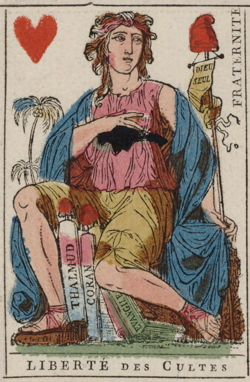 |
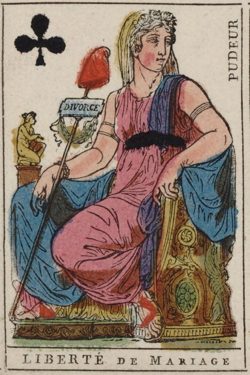 |
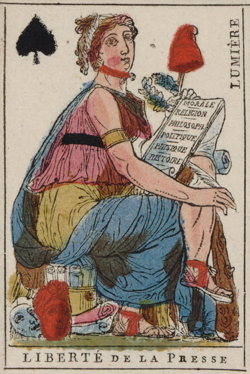 |
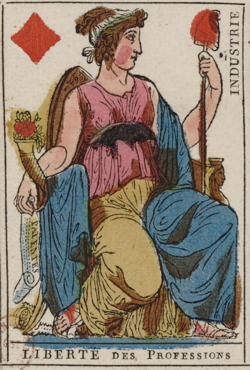 |
Beneath the overarching rule of law which governs all aspects of society are the main driving forces of society - War, Peace, the Arts, and Commerce - which in turn give rise to the four main kinds of Liberty which the people can enjoy, namely freedom of religion, of marriage, of the press, and of industry ("the professions"). Unlike the three Spirits mentioned above, these four "Liberties" are not wearing the Phrygian cap of liberty but brandish them on staffs or spears. They are also all female.
"Liberty of Religion" is holding one hand over her heart and in her other hand she is holding a spear on top of which is her symbolic cap and a pennant on which is written "God alone". Gathered together by her is The Talmud, the Koran, and the New Testament which are symbols of the three most famous religions. In the distance one can see a desert palm and to her side is written the word "Fraternity". [p. 2]
Thanks to "Divorce," Marriage will be nothing more than the voluntary combination of Modesty and Wisdom, which is what the word "Modesty" means, and the statuette of modest Venus which is placed next to "Liberty", (is) one of its homes. And the word "Divorce" which is written on the sign that she holds in her hand, is like a beneficial amulet which will remind spouses constantly that their faithfulness must be mutual in order to last. [p. 2]
"Liberty of the Press" appears to have written the word "History" after having dealt with "Morality", "Religion", "Philosophy", "Politics", and "Physics". At her feet lie several writings and the masks from two plays which are joined by a heroic trumpet; a wooden club, placed next to her, shows her strength, and the word "Enlightenment shows her effects. [p. 2] [Editor: Liberty of the Press is also holding in her right hand a laurel wreath].
"Liberty of the Professions" has for her attributes only a cornucopia and a pomegranate, symbols of fecundity. Her mottos are "Industry" and the "Trading License" (Patents) which she holds in her hand.
Equality (l'Égalité) replaces Knights/Knaves (Valets)
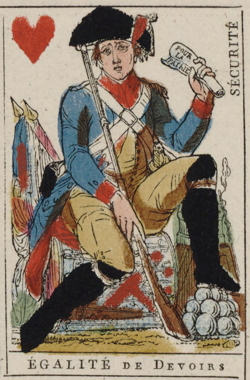 |
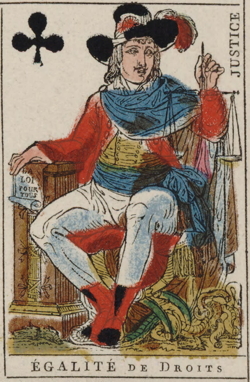 |
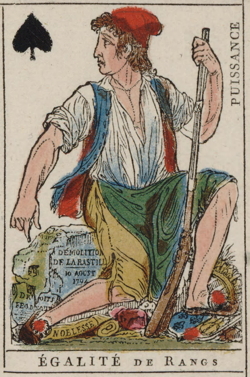 |
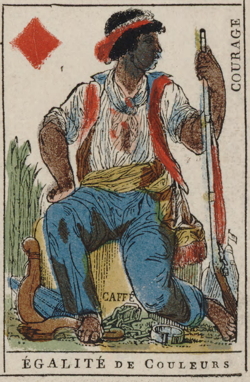 |
The four "Equalities" show some of the practical consequences of the rule of law and the liberties depicted above. Here we have four identifiable individuals rather than abstractions like "forces" or "Liberties" - namely, a member of the National Guard, a Judge, an ordinary sans-culottes, and an ex-slave.
[Equality of Duties] - Here is a National Guard whose devotion to the Country results in pubic "Security". This key word is written next to him. [p. 3] [Editor: The guardsman is sitting on an overtuned drum, behind him are his troop's colors. In his right hand he has a rifle, in his left hand is a folded piece of paper which says "For the Fatherland". His left foot is resting on top of a pile of cannon balls.
[Equality of Rights] - A Judge dressed in the costume of a Repubican (presumably) holds in one hand the scales of justice and the other hand is resting on the altar of the Law, which states that it is equal for all. He is treading underfoot the hydra of legal chicanery (squabbling) whose heads lie on the ground. Next to him is the word "Justice." [p. 3] [Editor: Equality of Rights is wearing a plumed hat and the altar of the law has a Roman fasces carved on it].
The "Equality of Classes" is represented by a man of the 14th July 1789 and of the 10th August 1792 who is armed and trampling underfoot the coat of arms and titles of the nobility. He points to the feudal rights which have been torn up and to the stone from the Bastille on which he sits. Next to him is the word "Strength". [p. 3] [Editor: The sans-culotte is pointing to a piece of rubble on which is written "demolition of the Bastille 10 August 1794". There are papers with the "feudal rights" and "nobility" written on them. Under his left foot is a heraldic shield of a noble family].
[Equality of Races] - The Negro, having broken free of his shackles, treads underfoot a broken yoke. Seated on a bail of coffee, he seems to enjoy again the pleasure of being free and being armed. To one side one can see a camp and on the other side some sugar cane. The word "Courage" (shows) that the Man of Colour has at last taken his revenge for the unjust disregard of his oppressors. [p. 3]
Conclusion
In the concluding "Observations" of the pamphlet, the authors clearly state that their intention has been to recognize the social, legal, economic, and political changes which "the love of liberty demands" [p. 4]. Yet they seem to sense that some of their illustrations might unnerve some readers (or card players), especially their defence of the right to divorce, and the legitimacy of the revolt of the sans-culottes against the feudal privileges of the nobility, and the uprising of the slaves against their masters. In the opening remarks to the pamphlet they quickly reassure their readers that all these changes have been achieved strictly under the guidance of the rule of law:
If the true friends of philosophy and humanity have noticed with pleasure that included among the Equality face cards are sans-culottes and negroes, they will especially like to see The Law as the sole sovereign of a free people. It surrounds the Ace of the supreme power, whose symbol is the fasces, and provides it with its name. [p.1]
Furthermore, they temper their thoughts on divorce by repeatedly stressing the importance of "modesty" (although they do remind the reader/player that marriage must be voluntary and mutual between both spouses in order to be long lasting).
The political views which lie behind the images Citizens Jaume and Dugourc created for their Republican deck of cards were those of the moderate, constitutional liberals of the first phase of the French Revolution, perhaps best resented by the Marquis de Condorcet and the Girondin faction. They believed in government limited by the rule of law; the freedom of religion, the press, and of commerce; and equality before the law regardless of sex, rank, or race. This group of moderate republicans were swept aside by the Jacobins who came to power during the Terror, many of them being forced into exile or killed like Condorcet. These playing cards thus represent those who had a different vision of the possibilities of the French Revolution than Robespierre in 1795 and then Napoleon in 1799.